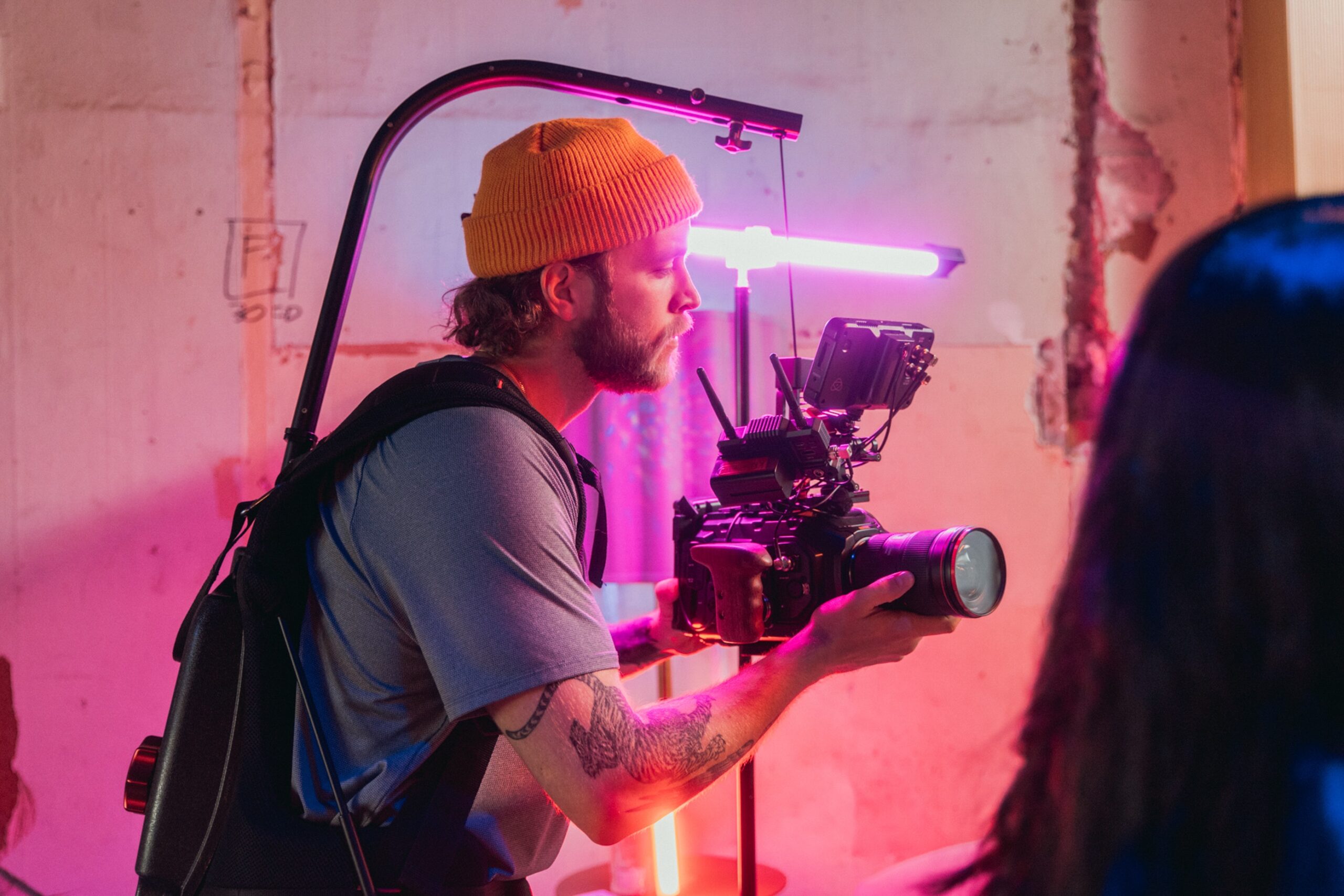Have you ever looked at a movie or a video clip and immediately recognized the director or cinematographer? That is because some films have a strong personal signature.
In this blog post, we’ll explore the fundamentals of signature cinematography and how you can use these techniques to create an individualized visual language of your own.
Read on to discover the secrets of crafting a distinctive visual style!
What is the Visual Language of a Film
Visual language is the way you compose your motion-picture photography. The choice of cameras, lenses, and filters. The way you light and frame your shots. The way you decide to visually narrate and shape a viewer’s perspective of a scene. And so on and so forth.
Think of it this way: all these elements – the color, the framing, the angles – are like the letters in the alphabet. To tell someone a story, you need to combine these letters into words and then arrange the words into coherent sentences. Now, the way you decide to do that is what determines your unique language. For example, to express love toward someone, you can be direct and say I love you, but you can also be playful, colorful, or poetic. It’s all up to you, and it’s exactly the same with visual language.
Your unique film style is determined by how you combine the letters in the alphabet of cinematography. Much like the words “secure” and “rescue” are written using the same letters, horror and passion are created on the screen using the same components of cinematography. They are just combined differently.
Why Develop Your Own Visual Language
Your own visual language allows you to tell stories in compelling and original ways. Ways that make it memorable. This does not mean you must shoot films that all look the same. But it does establish a framework within which you will operate.
Novice filmmakers may see these borders as limiting. Seasoned filmmakers, however, see them as liberating. Whenever you set some boundaries, you are forced to find creative answers within these frontiers. So instead of pulling solutions here and there and ending up with a chaotic piece of film that feels like an incoherent ramble, you stay where you are and dig a little beeper. And deeper is always better.
When you go in-depth, you’re not superficial anymore. Suddenly, you find yourself working on details. You don’t move from one block of stone to another. Instead, you stay put and keep chiseling, carefully honing out the masterpiece. Contrary to widespread belief, this attention to detail and working within limits often leads you to new, undiscovered lands filled with exciting possibilities.
How to Develop Your Own Visual Language
Whenever you ask this question from a seasoned cinematographer, you get an answer similar to this: it is not something you can force; it has to come from within and feel natural to you.
Hence, your unique visual language is not something you mold overnight. Instead, it’s a journey. But, as with all journeys, the sooner you get going, the sooner you arrive. And the good news is, unlike in many other areas of life, finding your signature cinematographic style is not hard work. It’s just a lot of work. It’s not some mystical and unreachable thing reserved only for superstar filmmakers. No. The truth is, we all have a unique voice, after all – we all are unique, so it’s just a matter of finding it, honing it out, and then perfecting it over time.
Now, let’s break down the process of creating your own visual language and see how we can get there in 9 straightforward steps.
1. Master the Fundamentals of Cinematography
To compose words, you need to learn the alphabet. To form sentences, you need to know the grammar. It’s the same with filmmaking. You can’t tell complex and compelling stories if you only learn part of the alphabet or are not familiar with the grammar of filmmaking. Otherwise, whatever you are trying to say would not make any sense. So, to develop your own visual language, it is essential to know the rules that govern visual storytelling and have a strong understanding of filmmaking fundamentals as well as the role of the cinematographer.
Creating the overall look and visual style may involve a sizable crew on a feature film or can be a single-person venture on a short documentary. Either way, it’s an all-encompassing role that requires, among all else, understanding color theory, composition, lighting, and camera movement. The more areas you feel comfortable in, the more playroom you have when developing your unique film style.
2. Study Films and Other Cinematographers
To gain insight into what works and what doesn’t, study well-established cinematographers and analyze their pictorial language. Not only the ones you admire but also those you don’t. Focus on the visuals of their films and take notes on what you like and dislike about their approach. Most importantly, notice what elements they utilize and how they create a cohesive look throughout their movies.
3. Use Other Art Forms for Inspiration
Find inspiration in other art forms, such as painting, music, or literature. That can help shape your visual style and storytelling approach. For example, in his heart, Michelangelo was always a sculptor first and a painter second. Yet he is most praised for his breathtaking paintings and their distinctive style. What gave Michelangelo’s paintings that characteristic look was his unique approach – he painted as if he was sculpting.
4. Experiment Boldly
Once you’ve become familiar with the rules, mastered the fundamentals, and have a general understanding of where you are heading, start experimenting. Don’t be afraid to make mistakes. Play with different cameras, lenses, and camera techniques. Try out various angles, lighting setups, and compositions. Approach differently to telling the same story. Take note of what works aesthetically and what doesn’t – then build on this knowledge when crafting shots/scenes/sequences in your upcoming projects.
5. Challenge Yourself
It is important to constantly challenge yourself to keep progressing. Never shy away from projects that require complex lighting setups or camera movement. Pushing yourself will nudge you out of your comfort zone and will ultimately help you grow as a filmmaker.
6. Collaborate Often
Cinematography is the art and technology of filmmaking. Meaning the cinematographer handles all the technical aspects of visual storytelling and is responsible for bringing a director’s vision to life. Even when you’re often wearing both hats – the directors and the cinematographers – collaborating with other filmmakers is an invaluable tool for getting feedback for your work and learning other people’s perspectives. It helps you gain valuable insights into what it takes to turn ideas into stories via moving pictures. It expands your toolset, essential for developing a one-of-a-kind cinematic style.
7. Be Mindful and Reflect
Taking action is critical to moving forward, but it’s equally crucial to ensure you are moving in the right direction. So make sure you take time to analyze your work and learn from it. Document your experiments, reflect on your previous work, and be present and mindful when taking the next steps. Make a habit of taking notes on what worked (or didn’t). That way, it’s easier to finetune your style as you go.
8. Connect With Your Feelings
Your signature cinematography should be an artwork with an authentic and clear voice – something that resonates with all parts of you. This can only come from within. So it’s not just about cameras, color, and composition. Finding a visual language that is true to you and touches people with its verismo requires you to put in more than just your skill – your heart.
Immerse yourself in your filmmaking ventures and connect your feelings with every scene you shoot. It can be uncomfortable at first, but it’s necessary for authenticity. This introspective approach to filmmaking gives you insight into your real nature, inner thoughts, and feelings. It connects you more deeply with your work. This often results in intricate visual stories with captivating characters that viewers can relate to on a personal level.
9. Devil Is in the Details
What separates a compelling cinematic language from one that falls flat is often little, barely noticeable details. Paying attention and fine tuning details adds complexity and depth that help create more meaningful films.
When you analyze accomplished cinematographers, their styles are rarely, if ever, radically different. Instead, what makes them unique usually comes down to a few minor details.
Take the award-winning cinematographer Roger Deakins, for example. He predominantly uses just a single camera and three straightforward lighting sources. Plus, he never scouts for exotic locations. Instead, he poetizes the everyday, and his visual language is gorgeous because of its simplicity.
Conclusion
Honing out that signature cinematography may seem like a hyper-complex process that requires juggling 17 burning pins while walking a tightrope, but it actually isn’t. Yes, it takes time. Yes, it needs work. And yes, it’s a road filled with awkward faceplants and constant dusting yourself off after getting back on your feet. But in the end, when you get there – and you will – it is that much more rewarding.
Nothing is more fulfilling than finally finding your voice. It’s an incredible feeling if, after all that grinding, dedication, and creative exploration, you finally discover that unique visual style that sets you apart from other filmmakers.
It’s a journey of growth and self-discovery. One that pushes you out of your comfort zone and encourages you to try new things. So, what do you have to lose? Take the first step and get going. It will take your craft to the next level by giving you a clear vision of the stories you want to tell and how you want to tell them.
Need more than inspiration?
Bold experiments and conquering new heights are much easier and faster if your gear is not limiting you. So set your creative potential free with the boundary-breaking memory cards and workflow solutions built by us for you – the courageous explorers.





